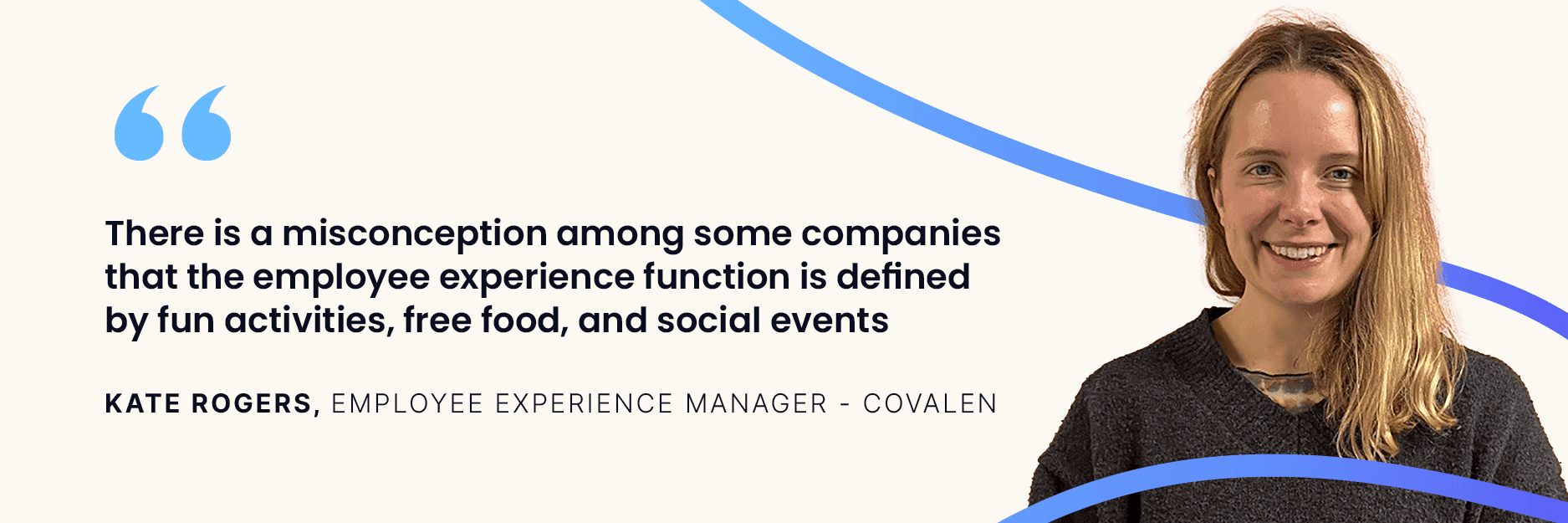A Day in the Life of an Employee Experience Manager

Lisa Ardill
Content Editor at Workvivo
March 28 2023

What does the mystical role of employee experience manager entail? Covalen’s Kate Rogers shares what a typical day in her job is like.
We’re super passionate about improving the employee experience at every company across the globe, and we couldn’t do it without the superstar internal comms and EX managers tirelessly championing workplace transformations.
But the exact role of an employee experience manager might not be obvious for other departments in an organization, so we want to have a go at demystifying it. Thankfully, Covalen’s Kate Rogers, who is the professional services firm’s Global Employee Experience Manager, is here to help.
What are your core responsibilities as an employee experience manager?
My core responsibilities are designing, developing, and effectively delivering global people programs that support a high-performance culture and drive a sense of belonging within the organization.
Did you always want to work in employee experience?
I am and have always been a people-centric person. Before becoming an Employee Experience Manager, I always gravitated toward people leadership roles, recognizing the impact that building a culture of inclusivity and trust within a team has on performance.
Completing my Masters in Strategic HR and gaining experience building and managing people programs in both the public and private sectors, guided me toward this leadership position in the employee experience space.
What do you find most rewarding about your job?
The most rewarding part of my job is designing and delivering programs that drive a sense of purpose and connect people to the organization that they work for. Whether that’s partnering with the leadership team to deliver global All Hands or designing and delivering recognition programs that reward people for the great work that they do, seeing how these programs drive a sense of purpose, connect people, and motivate them toward the organization’s goals is certainly the best part of my job.
There are so many factors that influence someone’s decision to stay or leave a company. Fewer and fewer people are looking for that ‘career for life’ and more are looking for a company that aligns with their values, provides clear career pathways, genuinely cares for their employee’s wellbeing, and provides an environment where people can thrive. Given the growth in the gig economy and growth in diverse career opportunities in the market, people aren’t afraid to bounce from company to company until they find somewhere that ticks these boxes.
This is where an Employee Experience Department can really add value to the organization’s talent strategy. By creating programs that connect people to the organization’s strategy whilst prioritizing trust, wellbeing, and inclusivity, organizations will find it much easier to attract, retain and motivate talent in highly competitive industries.

If you could clear up any misunderstandings people have about employee experience roles, what would they be?
Employee experience departments can offer far more than point-in-time engagement initiatives that the organization expects will solve challenges facing their retention strategy.
There is a misconception among some companies that the employee experience function is defined by fun activities, free food, social events, etc. And the more of this point-in-time engagement that a company can invest in, the more they will see a boost in talent retention.
While these point-in-time investments are certainly nice to have, they are not the answer to the organization’s talent retention strategy and will only provide a band-aid solution to some of the key challenges that are facing the employee experience in today’s world.
Instead of using the employee experience function to treat these issues superficially, companies can utilize the function analytically to perform a root cause analysis on specific challenges and implement strategic and bespoke interventions to address the challenges.
How do you approach creating a positive work environment for employees?
Developing programs that connect people to the organization’s strategy. To engage people in a positive working environment, it’s important that they understand how their individual contribution positively impacts the organization’s growth strategy. Programs that communicate the impact of individual and team successes and recognition programs that reward individual and team contributions to key strategic objectives will reinforce the importance and meaning of their work.
Ensuring that the organization’s communication platforms are optimized and fit for purpose. Poor communication is often referenced as the single largest challenge to the employee experience. Ensuring that people have a consistent and trusted source of information pertaining to issues or updates that impact them is crucial.
Implementing a communication strategy that supports a consistent and trusted source of communication from both the top down and down up will ensure that employees feel heard and provided with the information they need when they need it.
What strategies have you used to measure employee satisfaction and engagement?
I find that creating a robust feedback loop strategy is key when measuring the impact of employee experience programs.
Through quarterly surveys, pulse surveys, focus groups, and people dashboards, I am able to collect and analyze data and then feed this back into the business in the form of targeted intervention programs that address specific challenges in the employee experience.
Do you use any tools or systems to manage tasks related to employee experience?
Mural: Mural is a digital collaboration whiteboard that enables team collaboration when working in multiple working models.
Canva: Canva is a creative presentation and video editor. I use this to create engaging presentations and videos that appeal to visual learners within the organization. It provides an alternative communication platform over email and PowerPoint. Communication delivered using Canva is collaborative, enabling multiple teams to work on creative communications together and then deliver it at scale.
Powtoon: Enables us to create short and engaging explainer videos to easily inform people of new starters, projects, and business updates.
Airmeet: Enables us to create interactive and engaging virtual events. It has a stage-like setup which helps us differentiate the guest experience at regular Zoom calls from large-scale company events.
What are the skills you draw on most in your role?
Adapting to new technologies. It’s important to stay at the forefront of new technologies relating to a better employee experience. When it comes to connecting a global workforce across multiple working models, having the right digital tools and HR systems in place is key.
Relying on email and video calls alone will lead to fatigue and will see people gradually disengage or miss certain communications. Investing in EX systems that connect people to each other and the leadership team, allow employees to get answers quickly, and share information on important updates will help people do their job more effectively and provide a smooth end-to-end employee experience.
How do you stay up to date with the latest trends in employee experience management?
Staying connected to your external network is just as important as staying connected to your colleagues. Trends connected to the employee value proposition are always changing to better reflect what jobseekers in the market are looking for.
To ensure you provide a competitive employee experience, you have to stay connected to the market and understand what others are doing to improve the employee experience, and ask if that’s something that you can facilitate too.